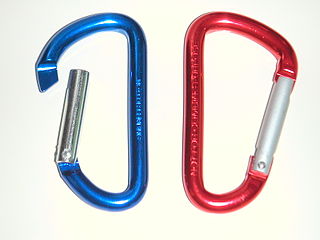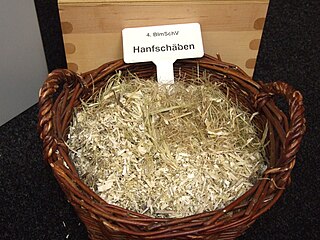
Rust is an iron oxide, a usually reddish-brown oxide formed by the reaction of iron and oxygen in the catalytic presence of water or air moisture. Rust consists of hydrous iron(III) oxides (Fe2O3·nH2O) and iron(III) oxide-hydroxide (FeO(OH), Fe(OH)3), and is typically associated with the corrosion of refined iron.

BASF SE is a German multinational chemical company and the largest chemical producer in the world. The BASF Group comprises subsidiaries and joint ventures in more than 80 countries and operates six integrated production sites and 390 other production sites in Europe, Asia, Australia, the Americas and Africa. Its headquarters is located in Ludwigshafen, Germany. BASF has customers in over 190 countries and supplies products to a wide variety of industries. Despite its size and global presence, BASF has received relatively little public attention since it abandoned manufacturing and selling BASF-branded consumer electronics products in the 1990s.
Passivation, in physical chemistry and engineering, refers to a material becoming "passive," that is, less affected or corroded by the environment of future use. Passivation involves creation of an outer layer of shield material that is applied as a microcoating, created by chemical reaction with the base material, or allowed to build from spontaneous oxidation in the air. As a technique, passivation is the use of a light coat of a protective material, such as metal oxide, to create a shell against corrosion. Passivation can occur only in certain conditions, and is used in microelectronics to enhance silicon. The technique of passivation strengthens and preserves the appearance of metallics. In electrochemical treatment of water, passivation reduces the effectiveness of the treatment by increasing the circuit resistance, and active measures are typically used to overcome this effect, the most common being polarity reversal, which results in limited rejection of the fouling layer. Other proprietary systems to avoid electrode passivation, several discussed below, are the subject of ongoing research and development.

Anodizing is an electrolytic passivation process used to increase the thickness of the natural oxide layer on the surface of metal parts.

Anti-fouling paint - a category of commercially available underwater hull paints - is a specialized category of coatings applied as the outer (outboard) layer to the hull of a ship or boat, to slow the growth and/or facilitate detachment of subaquatic organisms that attach to the hull and can affect a vessel's performance and durability. Anti-fouling paints are often applied as one component of multi-layer coating systems which may have other functions in addition to their antifouling properties, such as acting as a barrier against corrosion on metal hulls that will degrade and weaken the metal, or improving the flow of water past the hull of a fishing vessel or high-performance racing yachts.

Polyurea is a type of elastomer that is derived from the reaction product of an isocyanate component and a synthetic resin blend component through step-growth polymerization. The isocyanate can be aromatic or aliphatic in nature. It can be monomer, polymer, or any variant reaction of isocyanates, quasi-prepolymer or a prepolymer. The prepolymer, or quasi-prepolymer, can be made of an amine-terminated polymer resin, or a hydroxyl-terminated polymer resin.

Water softening is the removal of calcium, magnesium, and certain other metal cations in hard water. The resulting soft water requires less soap for the same cleaning effort, as soap is not wasted bonding with calcium ions. Soft water also extends the lifetime of plumbing by reducing or eliminating scale build-up in pipes and fittings. Water softening is usually achieved using lime softening or ion-exchange resins but is increasingly being accomplished using nanofiltration or reverse osmosis membranes.
A corrosion inhibitor is a chemical compound that, when added to a liquid or gas, decreases the corrosion rate of a material, typically a metal or an alloy, that comes into contact with the fluid. The effectiveness of a corrosion inhibitor depends on fluid composition, quantity of water, and flow regime. Corrosion inhibitors are common in industry, and also found in over-the-counter products, typically in spray form in combination with a lubricant and sometimes a penetrating oil. They may be added to water to prevent leaching of lead or copper from pipes.

Corona treatment is a surface modification technique that uses a low temperature corona discharge plasma to impart changes in the properties of a surface. The corona plasma is generated by the application of high voltage to an electrode that has a sharp tip. The plasma forms at the tip. A linear array of electrodes is often used to create a curtain of corona plasma. Materials such as plastics, cloth, or paper may be passed through the corona plasma curtain in order to change the surface energy of the material. All materials have an inherent surface energy. Surface treatment systems are available for virtually any surface format including dimensional objects, sheets and roll goods that are handled in a web format. Corona treatment is a widely used surface treatment method in the plastic film, extrusion, and converting industries.

Powder coating is a type of coating that is applied as a free-flowing, dry powder. Unlike conventional liquid paint which is delivered via an evaporating solvent, powder coating is typically applied electrostatically and then cured under heat or with ultraviolet light. The powder may be a thermoplastic or a thermoset polymer. It is usually used to create a hard finish that is tougher than conventional paint. Powder coating is mainly used for coating of metals, such as household appliances, aluminium extrusions, drum hardware, automobiles, and bicycle frames. Advancements in powder coating technology like UV curable powder coatings allow for other materials such as plastics, composites, carbon fiber, and MDF to be powder coated due to the minimum heat and oven dwell time required to process these components.

Iran Electronics Industries or Integrated Electronics Industries(IEI, Persian: صنایع الکترونیک ایران; also known as Persian: صاایران) is a state-owned subsidiary of Iran's Ministry of Defense. It is a diversified organization with operations in electronics, optics, electro-optics, communications, computer and semiconductors.
In agriculture and horticulture, seed treatment or seed dressing is a chemical, typically antimicrobial or fungicidal, with which seeds are treated prior to planting. Less frequently, insecticides are added. Seed treatments can be an environmentally more friendly way of using pesticides as the amounts used can be very small. It is usual to add colour to make treated seed less attractive to birds, and easier to see and clean up in the case of an accidental spillage. Specialist machinery is required to safely and efficiently apply the chemical to the seed. A seed coating is a thicker form of covering of seed and may contain fertiliser, growth promoters and or seed treatment as well as an inert carrier and a polymer outer shell. The term "seed dressing" is also used to refer to the process of removing chaff, weed seeds and straw from a seed stock.
LORD Corporation is a diversified technology and manufacturing company that develops adhesives, coatings, motion management devices, and sensing technologies for industries such as aerospace, automotive, oil and gas, and industrial. With world headquarters in Cary, North Carolina, LORD has approximately 3,100 employees in 26 countries and operates 19 manufacturing facilities and 10 R&D centers worldwide. As of October 30, 2019, the company has been acquired by Parker Hannifin.

SmartStax is a brand of genetically modified seed made through a collaboration between Monsanto Company and Dow Chemical Company. It takes advantage of multiple modes of insect protection and herbicide tolerance. SmartStax takes advantage of Yieldgard VT Triple (Monsanto), Herculex Xtra (Dow), RoundUp Ready 2 (Monsanto), and Liberty Link (Dow). The traits included protect against above-ground insects, below-ground insects, and provide broad herbicide tolerance. It is currently available for corn, but cotton, soybean, and specialty crop variations are to be released. Previously, the most genes artificially added to a single plant was three, but Smartstax includes eight. Smartstax also incorporates Monsanto's Acceleron Seed Treatment System which protects against insects at the earliest stages of development. Smartstax is sold under the Genuity (Monsanto) and Mycogen (Dow) brands.
Scarification in botany involves weakening, opening, or otherwise altering the coat of a seed to encourage germination. Scarification is often done mechanically, thermally, and chemically. The seeds of many plant species are often impervious to water and gases, thus preventing or delaying germination. Any process designed to make the testa more permeable to water and gases is known as scarification.

Kansai Nerolac Paints Limited is the largest industrial paint and third largest decorative paint company of India based in Mumbai. It is a subsidiary of Kansai Paint of Japan. As of 2015, it has the third largest market share with 15.4% in the Indian paint industry. It is engaged in the industrial, automotive and powder coating business. It develops and supplies paint systems used on the finishing lines of electrical components, cycle, material handling equipment, bus bodies, containers and furniture industries.

Tung oil or China wood oil is a drying oil obtained by pressing the seed from the nut of the tung tree. Tung oil hardens upon exposure to air, and the resulting coating is transparent and has a deep, almost wet look. Used mostly for finishing and protecting wood, after numerous coats, the finish can even look plastic-like. Related drying oils include linseed, safflower, poppy, and soybean oils. The oil and its use are believed to have originated in ancient China and appear in the writings of Confucius from about 400 BC. Raw tung oil tends to dry to a fine, wrinkled finish; the English name for this is gas checking; this property was used to make wrinkle finishes, usually by adding excess cobalt drier. To stop this, the oil is heated to gas-proof it, and most oils used for coating are gas-proofed, also known as "boiled".
According to EN 13523-0, a prepainted metal is a ‘metal on which a coating material has been applied by coil coating’. When applied onto the metallic substrate, the coating material forms a film possessing protective, decorative and/or other specific properties.

Acceleron Pharma, Inc. is a public American "clinical stage biopharmaceutical company" based in Cambridge, Massachusetts with a broad focus on developing medicines that regulate the transforming growth factor beta (TGF-β) superfamily of proteins, which play fundamental roles in the growth and repair of cells and tissues such as red blood cells, muscle, bone, and blood vessels.

Shives, also known as shoves or boon, are the wooden refuse removed during processing flax, hemp, or jute, as opposed to the fibres (tow). Shives consist of "the woody inner portion of the hemp stalk, broken into pieces and separated from the fiber in the processes of breaking and scutching" and "correspond to the shives in flax, but are coarser and usually softer in texture". Shives have traditionally been a by-product of fiber production.













